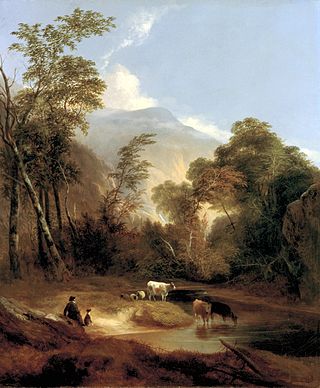
The pastoral genre of literature, art, or music depicts an idealised form of the shepherd's lifestyle – herding livestock around open areas of land according to the seasons and the changing availability of water and pasture. The target audience is typically an urban one. A pastoral is a work of this genre. A piece of music in the genre is usually referred to as a pastorale.
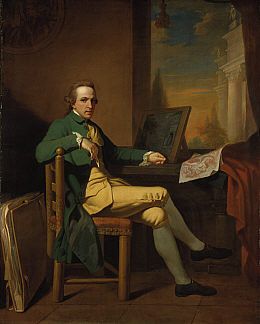
David Allan was a Scottish painter, limner, and illustrator, best known for historical subjects and genre works.

Allan Ramsay was a prominent Scottish portrait-painter.

Allan Ramsay was a Scottish poet, playwright, publisher, librarian and impresario of early Enlightenment Edinburgh.
An eclogue is a poem in a classical style on a pastoral subject. Poems in the genre are sometimes also called bucolics.
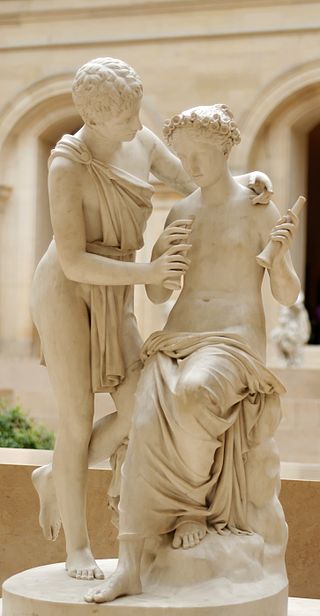
Daphnis and Chloe is an ancient Greek novel written in the Roman Empire, the only known work of the second-century AD Greek novelist and romance writer Longus.

William Hamilton (1704–1754) was a Scottish poet associated with the Jacobite movement.

Sir John Clerk, 2nd Baronet was a Scottish politician, lawyer, judge and composer. He was Vice-President of the Philosophical Society of Edinburgh, the pre-eminent learned society of the Scottish Enlightenment. Clerk was also the father of George Clerk-Maxwell and John Clerk of Eldin, and the great-great-grandfather of the famous physicist James Clerk Maxwell.

The pastoral pipe was a bellows-blown bagpipe, widely recognised as the forerunner and ancestor of the 19th-century union pipes, which became the uilleann pipes of today. Similar in design and construction, it had a foot joint in order to play a low leading note and plays a two octave chromatic scale. There is a tutor for the "Pastoral or New Bagpipe" by J. Geoghegan, published in London in 1745. It had been considered that Geoghegan had overstated the capabilities of the instrument, but a study on surviving instruments has shown that it did indeed have the range and chromatic possibilities which he claimed.

Baroque music of the British Isles bridged the gap between the early music of the Medieval and Renaissance periods and the development of fully fledged and formalised orchestral classical music in the second half of the eighteenth century. It was characterised by more elaborate musical ornamentation, changes in musical notation, new instrumental playing techniques and the rise of new genres such as opera. Although the term Baroque is conventionally used for European music from about 1600, its full effects were not felt in Britain until after 1660, delayed by native trends and developments in music, religious and cultural differences from many European countries and the disruption to court music caused by the Wars of the Three Kingdoms and Interregnum. Under the restored Stuart monarchy the court became once again a centre of musical patronage, but royal interest in music tended to be less significant as the seventeenth century progressed, to be revived again under the House of Hanover. The Baroque era in British music can be seen as one of an interaction of national and international trends, sometimes absorbing continental fashions and practices and sometimes attempting, as in the creation of ballad opera, to produce an indigenous tradition. However, arguably the most significant British composer of the era, George Frideric Handel, was a naturalised German, who helped integrate British and continental music and define the future of music in the United Kingdom.

Scottish opera is a subgenre of Scottish music. This article deals with three separate, but overlapping subjects:

Music in early modern Scotland includes all forms of musical production in Scotland between the early sixteenth century and the mid-eighteenth century. In this period the court followed the European trend for instrumental accompaniment and playing. Scottish monarchs of the sixteenth century were patrons of religious and secular music, and some were accomplished musicians. In the sixteenth century the playing of a musical instrument and singing became an expected accomplishment of noble men and women. The departure of James VI to rule in London at the Union of Crowns in 1603, meant that the Chapel Royal, Stirling Castle largely fell into disrepair and the major source of patronage was removed from the country. Important composers of the early sixteenth century included Robert Carver and David Peebles. The Lutheranism of the early Reformation was sympathetic to the incorporation of Catholic musical traditions and vernacular songs into worship, exemplified by The Gude and Godlie Ballatis (1567). However, the Calvinism that came to dominate Scottish Protestantism led to the closure of song schools, disbanding of choirs, removal of organs and the destruction of music books and manuscripts. An emphasis was placed on the Psalms, resulting in the production of a series of Psalters and the creation of a tradition of unaccompanied singing.

Scottish art in the eighteenth century is the body of visual art made in Scotland, by Scots, or about Scottish subjects, in the eighteenth century. This period saw development of professionalisation, with art academies were established in Edinburgh and Glasgow. Art was increasingly influenced by Neoclassicism, the Enlightenment and towards the end of the century by Romanticism, with Italy becoming a major centre of Scottish art.

Literature in early modern Scotland is literature written in Scotland or by Scottish writers between the Renaissance in the early sixteenth century and the beginnings of the Enlightenment and Industrial Revolution in mid-eighteenth century. By the beginning of this era Gaelic had been in geographical decline for three centuries and had begun to be a second class language, confined to the Highlands and Islands, but the tradition of Classic Gaelic Poetry survived. Middle Scots became the language of both the nobility and the majority population. The establishment of a printing press in 1507 made it easier to disseminate Scottish literature and was probably aimed at bolstering Scottish national identity.
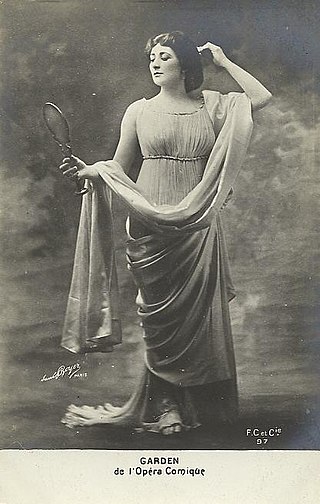
Classical music in Scotland is all art music in the Western European classical tradition, between its introduction in the eighteenth century until the present day. The development of a distinct tradition of art music in Scotland was limited by the impact of the Scottish Reformation on ecclesiastical music from the sixteenth century. Concerts, largely composed of "Scottish airs", developed in the seventeenth century and classical instruments were introduced to the country. Music in Edinburgh prospered through the patronage of figures including the merchant Sir John Clerk of Penicuik. The Italian style of classical music was probably first brought to Scotland by the cellist and composer Lorenzo Bocchi, who travelled to Scotland in the 1720s. The Musical Society of Edinburgh was incorporated in 1728. Several Italian musicians were active in the capital in this period and there are several known Scottish composers in the classical style, including Thomas Erskine, 6th Earl of Kellie, the first Scot known to have produced a symphony.
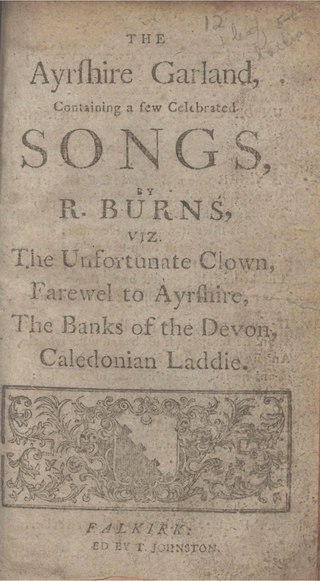
Music of Scotland in the eighteenth century includes all forms of music made in Scotland, by Scottish people, or in forms associated with Scotland, in the eighteenth century. Growing divisions in the Scottish kirk between the Evangelicals and the Moderate Party resulted in attempt to expand psalmondy to include hymns the singing of other scriptural paraphrases.
Events from the year 1725 in Scotland.

A maud is a woollen blanket or plaid woven in a pattern of small black and white checks known as Border tartan, Shepherd's check, Shepherd's plaid or Galashiels grey. It was in common use as an item of clothing in the southern counties of Scotland and the northern counties of England until the early twentieth century.

Archibald Burns (1831–1880) was a Scottish photographer based in Edinburgh, Scotland, and active from 1858 to 1880. He documented the city through various publications and recorded the historic buildings in a section of the city that was cleared for improvements in the 1860s.
Alexander Pennycuik (or Pennecuick) (1605-1695) was a Scottish military surgeon who became Surgeon General of the Scots forces in Ireland during the English Civil War. He was elected Deacon (President) of the Incorporation of Surgeons and Barbers of Edinburgh

















